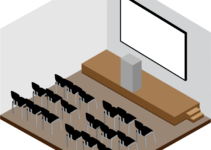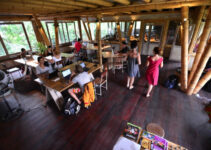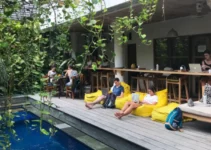(upbeat music) – [Adam Falk] At LinkedIn's
flagship office space, there are more than 75
different types of seating. – This feels like a spot for
maybe a really quick call or just answering a couple of emails. Work or NBA Jam. Yeah. This is your
space. And this is mine. – Yeah. This is my space,
and that's your space. – [Adam Falk] Many of these seats were actually meant to be desks. – So I think during our initial plans, we had just standard desks in this space with traditional conference
rooms and huddle rooms. – [Adam Falk] But the
pandemic changed that. – How much of what we're
seeing in this space is new as a result of the pandemic? – 100% of it. – [Adam Falk] This recently opened space is designed for hybrid work, a model that has emerged
as the leading choice for LinkedIn and others, with 42% of people with
remote capable jobs working partly at home, according to a February Gallup poll.
So what does a hybrid office look like? I toured Building One with the
project's leaders to find out and to get a glimpse into
what could be the future of workplace design. (upbeat music) Building One is the new
hub of LinkedIn's campus in Silicon valley. It has six floors, roughly
239,000 square feet, and room for about 1,500 employees – Prior to the pandemic, when
we looked at this building, really at that point the main goal was fitting as many people
as we could in this space. – [Adam Falk] The original floor plans called for 1,080 individual workstations. The thinking was, "One
employee, one desk." – Once we were sent home
during the pandemic, a lot of that changed. And much of what we
were trying to solve for before the pandemic was not the same thing that we were looking at at that moment.
(upbeat music) – [Adam Falk] So with the help of its design partners at NBBJ, LinkedIn retooled the space, cutting the number of desks
in half to 569 workstations and adding dozens of new,
nontraditional seating setups. – What did you and LinkedIn
learn from the pandemic that would result in the
space that we're in right now? – I think we really wanted to
do a lot of experimentation, because we just didn't know.
No one had a crystal ball about what the future would actually be. So we wanted to provide as many variety of spaces as possible. (upbeat music) (door opens) – [Adam Falk] The variety starts right when employees walk in. The design does away with a
large lobby in favor of a cafe. – Daniel and Adam. – This is one of my favorite
spaces of the buildings. The idea of this space is
that the minute you walk in, you feel the buzz, there's
people getting coffee, there's people moving
throughout the space. – [Adam Falk] The cafe spills
into the first of two areas LinkedIn calls its co-working spaces. Think open, non-reserved seating. The co-working area on the second floor was added in the redesign. – So we've got primary work points here. – [Adam Falk] Desks with monitors and tall backed booths with
Ottomans dot the space that, looking back at the original design, was once full of assigned workstations.
– So a space like this is
great for those smaller time periods where you might
come in and work with your team and then go home and do some focus time. Or for vice versa. – And that's okay with LinkedIn, to come in for half the day and work at home for half the day? – Yeah LinkedIn's approach is that
we are leading with trust. (upbeat music) The idea is that we trust
our employees to make the decision that's gonna be
best for them and their team. – [Adam Falk] Co-working is
open to anyone in the company for any amount of time.
Employees assigned to the building who plan to work there all
day will likely move upstairs. – The concept behind how
the floors are planned is the entry to the building
is the most social. And the farther that
you get into the space, it becomes more focused – [Adam Falk] Workers sit
in so-called neighborhoods or areas assigned to their teams. – We call this the living room. – [Adam Falk] Neighborhoods are split, about half alternative workspaces and half traditional desks.
Those desks are mostly here in the back. – Was this sort of what the whole floor was meant to look like
before the pandemic. – It is what the whole floor looked like before the pandemic. – What led the decision
to get rid of desk space? – Because we imagined that not everyone is going to come to
work eight hours a day. – [Adam Falk] So rather
than fill the space with potentially empty desks, of which I still saw plenty,
new furniture was added based on something called
the postures matrix. – The postures matrix is
about the amount of time that we imagine a person would be working doing a certain activity, combined with the amount of
ergonomics to support that. – So how long am I meant to
spend at this chair here? – So as a high table we imagine
that you spend less time compared to a low, standard table. So this would be used
maybe 30 to 60 minutes.
– [Adam Falk] LinkedIn
employees in Building One don't have assigned desks. Instead they can grab a seat
anywhere in their neighborhood. But it's not quite hot-desking either, as seats don't need to be reserved. – Even before the pandemic, our desk utilization I
think was around 30 to 40% – 30 to 40%? – Meaning that even though people might be in the office all day,
they're at meetings, they're at lunch, they might be sick, or just not in the office. And so now we're really looking at what does that desk utilization
look like in a hybrid world? – Do you know what that is yet? – No.
(laughter) – [Adam Falk] But in a hybrid office, (upbeat music) the individual setup is arguably
easier to design for it. It's the conference room that's tricky. Here, LinkedIn is, again, experimenting, from conference rooms that
look like living rooms- – What we wanted to do was
to take away the formality of meetings from offsite to onsite, and put people in a neutral position where if you are at home as
a part of the conversation, you're feeling very comfortable interacting with your colleagues. – [Adam Falk] To conference
rooms packed with tech, including cameras
positioned at table height that reframe to better show the speaker. – So it makes it a little bit more like you're sitting at the table. – [Adam Falk] And cameras that help make the physical digital.
– When folks are actually
writing on this white board, typically what you would be
doing is writing like this and a camera would be behind
you shadowing other people from seeing what it is that
you you're actually doing. – Right, they wouldn't be able to see actually what's going on. – This technology ghosts you out so that people that are remote
can see what you're writing. – Can we test it? – Let's do it.
– All right. (dry erase marker squeaking) – [Adam Falk] I'm standing
in front of it now. – [Robert Norwood] See
what it's capturing? – [Adam Falk] Yeah. I see what you mean. – So you have this new
space with all of these new bits of technology and
different types of seating. Is it meant to encourage people to come back into the office? – I think it's meant to welcome people if that's where they need to be. But if that person is
gonna do their best work and have their best
contributions to their team while being remote, that's okay.
(upbeat music) – [Adam Falk] That flexibility
may not be possible for some companies. And others like Tesla
simply aren't interested. But LinkedIn sees Building
One as a kind of test. One that others could learn from. – To what extent is what we're seeing here in LinkedIn's office the future of work? – What we have is an awesome
opportunity to experiment and to see what happens over time. And this is entirely flexible space. It might turn out that what we need are more desks in the future and that this could be changed into that. Or it might turn into a
completely different model. But the experimentation
and the observation is really the key to
seeing what the future is. (upbeat music continues).




